Heidi Weber & Le Corbusier – Friendship and Cooperation
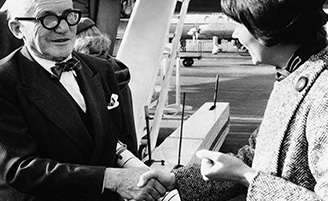
Heidi Weber & Le Corbusier Airport Zürich
The Handshake
The 71-year-old artist is confronted by a charismatic 31-year-old woman with purposeful resolve. She is highly motivated to further the dormant potential of his pictorial art work.
The secret of the understanding, the friendship between Le Corbusier and me, lies in the very moment, during our first meeting, when we shook hands. Every time we shook hands, every time we talked, he confirmed his confidence, his respect, his friendship. During the seven years of our collaboration, we didn’t need any words. The confidence we had in one another was sufficient. By the strengh of the intensity of his handshake, he transmitted his energy to me, his will, his wish, his knowledge. (Heidi Weber)
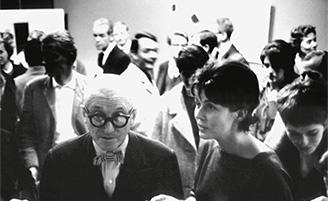
Exhibitions in Studio "Mezzanin" – Heidi Webers Studio of interior design
Heidi Weber – great patron of Le Corbusier
Heidi Weber’s first exhibition, entitled “Le Corbusier: Paintings - Tapetries - Drawings - Lithos - Furniture”, took place from February to April, 1959. Between 1959 and 1963, Le Corbusier took several important decisions regarding his collaboration with Heidi Weber. In 1959, the first signed contract granted Heidi Weber the exclusive right to manufacture and to sell Le Corbusier's four original models for seated furniture in Europe and the United States. On June 4th, 1962, Le Corbusier drew up a contract. This contract granted Heidi Weber (personally, and for a period of thirty years) the exclusive right to buy his works directly from him as well as from the Le Corbusier Fondation which was being developed at that point; it also gave her the right to sell his paintings, drawings, sculptures, enamel pieces, gouaches and collages throughout the whole world.
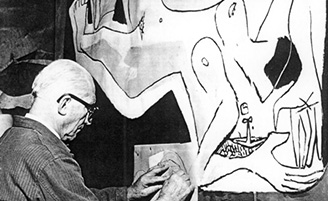
Heidi Weber and Le Corbusier’s Tapestries “Muralnomade”
Le Corbusier created over thirty original full size cardboard designs as large-scale collages
In February 1959, Le Corbusier lent Heidi Weber for her first sale exhibition, three paintings, ten aquarell-pastells and the two impressive tapestries „Les Musiciennes“ and ‘Les Mains“. Heidi Weber was fascinated by the tapestries with great compositions and colours. As she shared Le Corbusier‘s proggressive ideas for living, she immediately recognised the quality of these transportable wall-paintings of wool. She was able to draw on her considerable experience as an interior designer for the placement of the tapestries. In spite of her skills, the tapestries proved difficult to sell because of their size and their striking vibrancy. Collectors would have the courage to try something new. The high costs of production and the narrow profit margin on these hand manufactured products from Aubusson complicated this further. This is why these pieces were rarely sold in the Parisan galleries. This situation changed when Heidi Weber accepted these ‘wall nomads’: Le Corbusier asked her to dedicate herself particularly to these tapestries, as their creation was very impotant to him. Heidi Weber realized that this large size was best suited to public spaces; this was very important to her, as the tapestries could seen by the wider public. Art, in her opinion, shouldn‘t be left on its own in a warehouse; it should be made accessible to as many people as possible. During a time period of about twenty years, she was able to place a total of thirty-six tapestries in private and public buildings. She produced many of the larger sizes to be woven without any guarantee of sale because her conviction in the art work was greater than business principles and she was willing to take the risk.
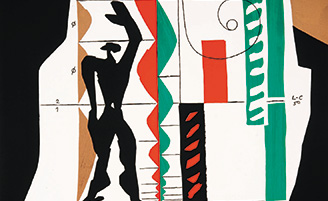
Lithographs of highest quality for the public
The Collaborative Lithographic Work “Le Corbusier – Heidi Weber”
Heidi Weber was not content to simply collect Le Corbusier‘s pictures, she also encouraged Le Corbusier to give his poetry an expression which could be accessed and afford by those who were interested in art, but who had limited financial resources. It began with copperplates which Heidi Weber brought to Le Corbusier to be engraved. She was able to convince him to create and distribute her concept. In spring 1960, Le Corbusier introduced her to the famous Parisan printer, Fernand Mourlot. Although the creation of the individual lithographic works is solely due to Le Corbusier‘s efforts, we have to thank Heidi Weber for the fact that these lithographic works actually came into existance, as the genesis of these works can be traced back to her initiative and her encouragement. Fernand Mourlot’s craftmens artwork and precision ensured the quality of the lithographs. The most important aspect about this story is Heidi Weber’s infallible engagement and the cooperation between herself and Le Corbusier promoting his creativity and art while simultaneously making his work accessible to the larger public.
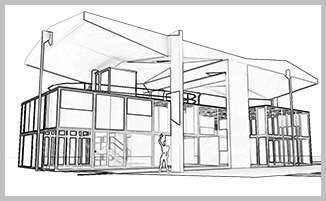
A visionary woman
From Mezzanin to a world-famous building
Heidi Weber’s relationship with Le Corbusier developed around his art and she constantly felt that there was more to be done and that there were new areas which required her attention. In 1960, she conceived the idea of a museum designed by Le Corbusier, which could contain the entire collection of his plastic works, his tapestries, his seated furniture and his books. An ambitious programme of exhibitions could also be hosted here. This new challenge was motivated not only by artistic reasons but by the virtuous idea of promoting Le Corbusier’s works at their very best within a masterpiece of Le Corbusier’s architecture! Until this point, no one had ever proposed such a challenging concept to Le Corbusier. This intention of investing in a conceptual synthesis of arts emphasised, without any euphemistic diminution, the messianic notion of the artist’s works which Heidi Weber wished to promote. The challenge was even greater, as, at that time, there was no private museum in Switzerland which had been realised or directed by a woman.
